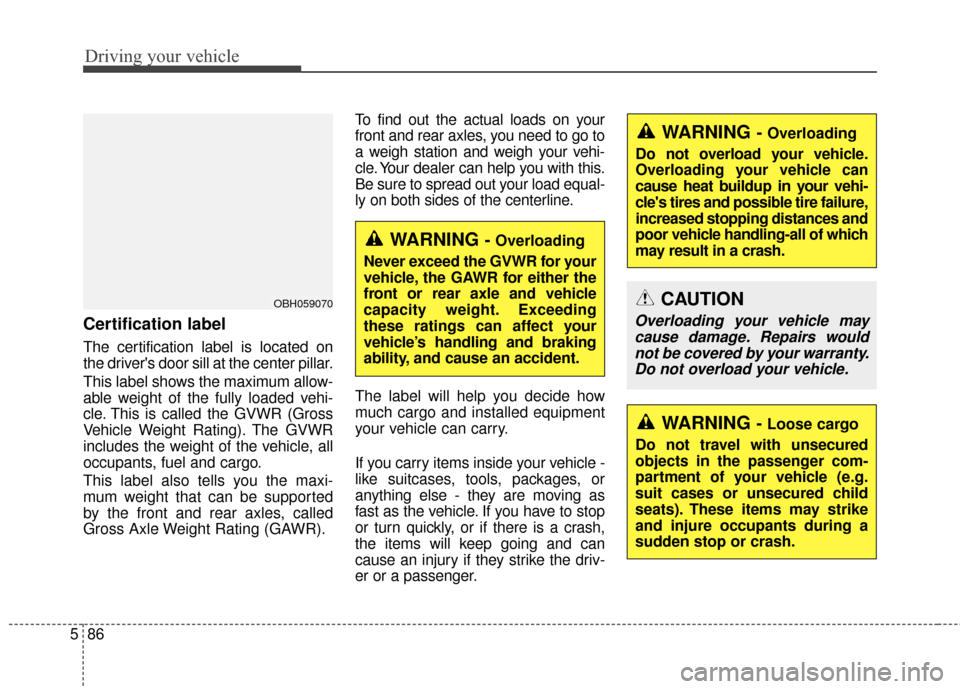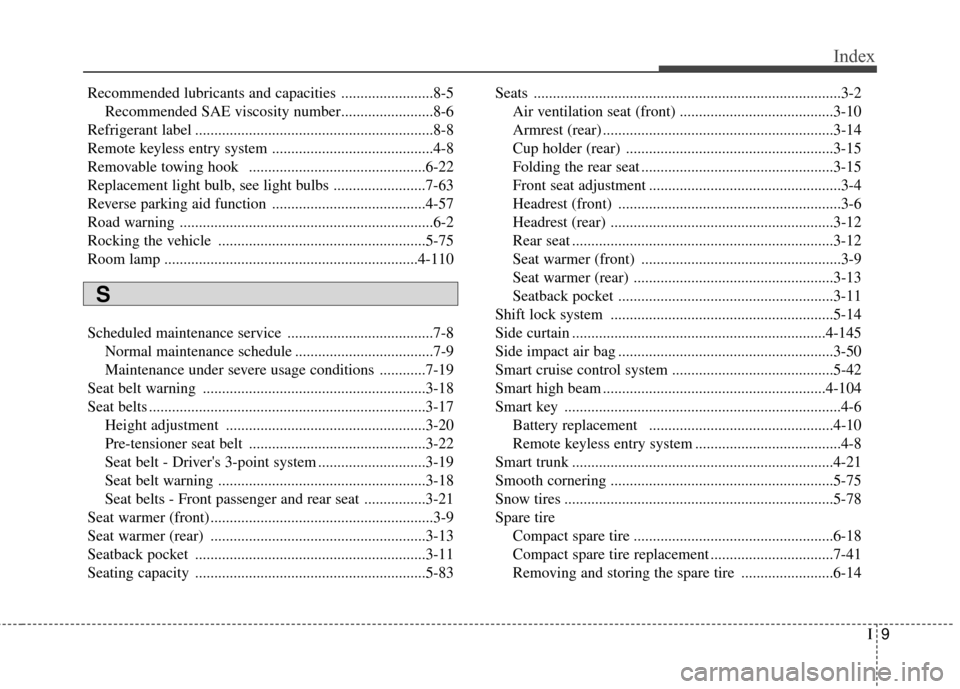2016 Hyundai Azera seats
[x] Cancel search: seatsPage 79 of 521

359
Safety features of your vehicle
Additional safety precautions
All occupants should sit upright,fully back in their seats with their
seat belts on and their feet on the
floor.
Passengers should not move
out of or change seats while the
vehicle is moving. A passenger
who is not wearing a seat belt dur-
ing a crash or emergency stop can
be thrown against the inside of the
vehicle, against other occupants,
or out of the vehicle.
Each seat belt is designed to
restrain one occupant. If more
than one person uses the same
seat belt, they could be seriously
injured or killed in a collision.
Do not use any accessories on
seat belts. Devices claiming to
improve occupant comfort or repo-
sition the seat belt can reduce the
protection provided by the seat belt
and increase the chance of serious
injury in a crash.
Passengers should not place
hard or sharp objects between
themselves and the air bags.
Carrying hard or sharp objects on
your lap or in your mouth can result
in injuries if an air bag inflates.
Keep occupants away from the
air bag covers. All occupants
should sit upright, fully back in their
seats with their seat belts on and
their feet on the floor. If occupants
are too close to the air bag covers,
they could be injured if the air bags
inflate.
Do not attach or place objects
on or near the air bag covers.
Any object attached to or placed
on the front or side air bag covers
could interfere with the proper
operation of the air bags.
Do not modify the front seats.
Modification of the front seats
could interfere with the operation of
the supplemental restraint system
sensing components or side air
bags.
Do not place items under the
front seats. Placing items under
the front seats could interfere with
the operation of the supplemental
restraint system sensing compo-
nents and wiring harnesses.
Never hold an infant or child on
your lap. The infant or child could
be seriously injured or killed in the
event of a crash. All infants and
children should be properly
restrained in appropriate child
safety seats or seat belts in the
rear seat.
Page 391 of 521

Driving your vehicle
86
5
Certification label
The certification label is located on
the driver's door sill at the center pillar.
This label shows the maximum allow-
able weight of the fully loaded vehi-
cle. This is called the GVWR (Gross
Vehicle Weight Rating). The GVWR
includes the weight of the vehicle, all
occupants, fuel and cargo.
This label also tells you the maxi-
mum weight that can be supported
by the front and rear axles, called
Gross Axle Weight Rating (GAWR). To find out the actual loads on your
front and rear axles, you need to go to
a weigh station and weigh your vehi-
cle. Your dealer can help you with this.
Be sure to spread out your load equal-
ly on both sides of the centerline.
The label will help you decide how
much cargo and installed equipment
your vehicle can carry.
If you carry items inside your vehicle -
like suitcases, tools, packages, or
anything else - they are moving as
fast as the vehicle. If you have to stop
or turn quickly, or if there is a crash,
the items will keep going and can
cause an injury if they strike the driv-
er or a passenger.
OBH059070
WARNING - Overloading
Never exceed the GVWR for your
vehicle, the GAWR for either the
front or rear axle and vehicle
capacity weight. Exceeding
these ratings can affect your
vehicle’s handling and braking
ability, and cause an accident.
WARNING - Overloading
Do not overload your vehicle.
Overloading your vehicle can
cause heat buildup in your vehi-
cle's tires and possible tire failure,
increased stopping distances and
poor vehicle handling-all of which
may result in a crash.
CAUTION
Overloading your vehicle may cause damage. Repairs wouldnot be covered by your warranty.Do not overload your vehicle.
WARNING - Loose cargo
Do not travel with unsecured
objects in the passenger com-
partment of your vehicle (e.g.
suit cases or unsecured child
seats). These items may strike
and injure occupants during a
sudden stop or crash.
Page 464 of 521

747
Maintenance
Tire terminology and definitions
Air Pressure: The amount of air
inside the tire pressing outward on
the tire. Air pressure is expressed in
pounds per square inch (psi) or kilo-
pascal (kPa).
Accessory Weight: This means the
combined weight of optional acces-
sories. Some examples of optional
accessories are, automatic
transaxle, power seats, and air con-
ditioning.
Aspect Ratio : The relationship of a
tire's height to its width.
Belt: A rubber coated layer of cords
that is located between the plies and
the tread. Cords may be made from
steel or other reinforcing materials.
Bead: The tire bead contains steel
wires wrapped by steel cords that
hold the tire onto the rim.
Bias Ply Tire : A pneumatic tire in
which the plies are laid at alternate
angles less than 90 degrees to the
centerline of the tread. Cold Tire Pressure: The amount of
air pressure in a tire, measured in
pounds per square inch (psi) or kilo-
pascals (kPa) before a tire has built
up heat from driving.
Curb Weight: This means the weight
of a motor vehicle with standard and
optional equipment including the
maximum capacity of fuel, oil and
coolant, but without passengers and
cargo.
DOT Markings: A code molded into
the sidewall of a tire signifying that
the tire is in compliance with the U.S.
Department of Transportation motor
vehicle safety standards. The DOT
code includes the Tire Identification
Number (TIN), an alphanumeric des-
ignator which can also identify the
tire manufacturer, production plant,
brand and date of production.
GVWR: Gross Vehicle Weight Rating
GAWR FRT: Gross Axle Weight
Rating for the Front Axle.
GAWR RR: Gross Axle Weight
Rating for the Rear axle.(Continued)
If the tire is impacted, inspect the tire condition or contact anauthorized HYUNDAI dealer.
To prevent damage to the tire, inspect the tire condition andpressure every 1,800miles(3,000km).
CAUTION
It is not easy to recognize the tire damage with your owneyes. But if there is the slight-est hint of tire damage, eventhough you cannot see the tiredamage with your own eyes,have the tire checked orreplaced because the tiredamage may cause air leak-age from the tire.
If the tire is damaged by driv- ing on a rough road, off road,pothole, manhole, or curbstone, it will not be covered bythe warranty.
You can find out the tire infor- mation on the tire sidewall.
Page 495 of 521

Maintenance
78
7
Interior care
Interior general precautions
Prevent chemicals such as perfume,
cosmetic oil, sun cream, hand clean-
er, and air freshener from contacting
the interior parts because they may
cause damage or discoloration. If they
do contact the interior parts, wipe
them off immediately. See the instruc-
tions for the proper way to clean vinyl.
Cleaning the upholstery and inte-
rior trim
Vinyl
Remove dust and loose dirt from
vinyl with a whisk broom or vacuum
cleaner. Clean vinyl surfaces with a
vinyl cleaner.
Fabric
Remove dust and loose dirt from fab-
ric with a whisk broom or vacuum
cleaner. Clean with a mild soap solu-
tion recommended for upholstery or
carpets. Remove fresh spots imme-
diately with a fabric spot cleaner. If
fresh spots do not receive immediate
attention, the fabric can be stained
and its color can be affected. Also, its
fire-resistant properties can be
reduced if the material is not proper-
ly maintained.
Using anything but recommended
cleaners and procedures may affect
the fabric’s appearance and fire-
resistant properties.
Cleaning the lap/shoulder beltwebbing
Clean the belt webbing with any mild
soap solution recommended for
cleaning upholstery or carpet. Follow
the instructions provided with the
soap. Do not bleach or re-dye the
webbing because this may weaken it.
Cleaning the interior window glass
If the interior glass surfaces of the
vehicle become fogged (that is, cov-
ered with an oily, greasy or waxy
film), they should be cleaned with
glass cleaner. Follow the directions
on the glass cleaner container.
CAUTION- Rear windows
Do not scrape or scratch theinside of the rear window. Thismay result in damage to the rearwindow defroster grid.CAUTION - Leather
When cleaning leather products(steering wheel, seats etc.), useneutral detergents or low alco-hol content solutions. If you usehigh alcohol content solutionsor acid/alkaline detergents, thecolor of the leather may fade orthe surface may get stripped off.
CAUTION - Electrical
componants
Never allow water or other liquidsto come in contact with electrical/electronic components inside thevehicle as this may damage them.
Page 518 of 521

I9
Index
Recommended lubricants and capacities ........................8-5Recommended SAE viscosity number........................8-6
Refrigerant label ..............................................................8-8
Remote keyless entry system ..........................................4-8
Removable towing hook ..............................................6-22
Replacement light bulb, see light bulbs ........................7-63
Reverse parking aid function ........................................4-57
Road warning ..................................................................6-2
Rocking the vehicle ......................................................5-75
Room lamp ..................................................................4-110
Scheduled maintenance service ......................................7-8 Normal maintenance schedule ....................................7-9
Maintenance under severe usage conditions ............7-19
Seat belt warning ..........................................................3-18
Seat belts ........................................................................\
3-17 Height adjustment ....................................................3-20
Pre-tensioner seat belt ..............................................3-22
Seat belt - Driver's 3-point system ............................3-19
Seat belt warning ......................................................3-18
Seat belts - Front passenger and rear seat ................3-21
Seat warmer (front) ..........................................................3-9
Seat warmer (rear) ........................................................3-13
Seatback pocket ............................................................3-11
Seating capacity ............................................................5-83 Seats ........................................................................\
........3-2
Air ventilation seat (front) ........................................3-10
Armrest (rear) ............................................................3-14
Cup holder (rear) ......................................................3-15
Folding the rear seat ..................................................3-15
Front seat adjustment ..................................................3-4
Headrest (front) ..........................................................3-6
Headrest (rear) ..........................................................3-12
Rear seat ....................................................................3-12\
Seat warmer (front) ....................................................3-9
Seat warmer (rear) ....................................................3-13
Seatback pocket ........................................................3-11
Shift lock system ..........................................................5-14
Side curtain ..................................................................4-145
Side impact air bag ........................................................3-50
Smart cruise control system ..........................................5-42
Smart high beam ..........................................................4-104
Smart key ........................................................................\
4-6 Battery replacement ................................................4-10
Remote keyless entry system ......................................4-8
Smart trunk ....................................................................4-21\
Smooth cornering ..........................................................5-75
Snow tires ......................................................................5-\
78
Spare tire Compact spare tire ....................................................6-18
Compact spare tire replacement ................................7-41
Removing and storing the spare tire ........................6-14
S